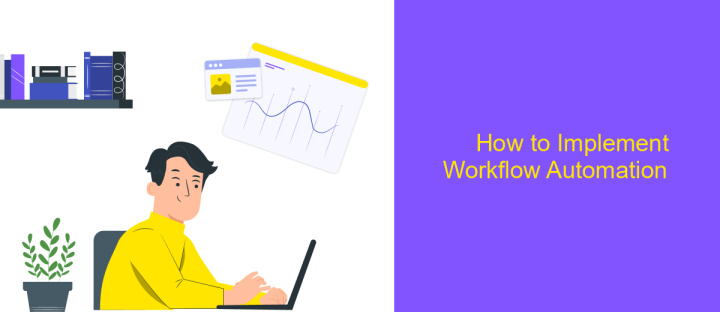What Should You Specify in the Workflow Automation
In today's fast-paced business environment, workflow automation is essential for enhancing productivity and efficiency. To fully leverage its benefits, it's crucial to specify key elements in your automation strategy. This article will guide you through the essential aspects to consider, ensuring your workflow automation is both effective and tailored to your organization's unique needs.
What Tasks Should You Automate?
When considering workflow automation, it's crucial to identify tasks that will benefit most from automation. Automating repetitive and time-consuming tasks not only increases efficiency but also reduces the risk of human error.
- Data Entry: Automate the input of data into systems to save time and minimize errors.
- Email Marketing: Use automation for sending out newsletters, promotional offers, and follow-up emails.
- Customer Support: Implement chatbots to handle common queries and support tickets.
- Social Media Management: Schedule posts and manage interactions across various platforms.
- Integration of Services: Utilize tools like ApiX-Drive to seamlessly connect different applications and services, ensuring smooth data flow and communication.
By focusing on these key areas, businesses can streamline their operations and free up valuable time for more strategic activities. Tools like ApiX-Drive can be particularly useful for integrating various services, making it easier to manage workflows and maintain consistency across different platforms.
How to Prioritize Which Tasks to Automate

When deciding which tasks to automate, it's crucial to start by identifying repetitive and time-consuming processes that drain resources. Tasks that require minimal human intervention, such as data entry, report generation, and email responses, are ideal candidates. Prioritize tasks that have a high volume and frequency, as automating these can significantly boost efficiency and reduce errors. Additionally, consider the potential return on investment (ROI) by evaluating how much time and money automation will save in the long run.
Next, assess the complexity and feasibility of automating specific tasks. Some processes may require advanced AI and machine learning capabilities, while others can be handled with simpler tools. For instance, integrating various applications and services can streamline workflows, and tools like ApiX-Drive can simplify this process. ApiX-Drive allows you to connect different platforms without extensive coding, making it easier to automate data transfers and other routine tasks. By focusing on tasks that are both impactful and feasible to automate, you can ensure a smoother transition and more effective workflow automation.
How to Choose the Right Workflow Automation Tool

Choosing the right workflow automation tool is crucial for streamlining your business processes and enhancing productivity. The ideal tool should cater to your specific needs and be adaptable to your existing systems.
- Identify Your Needs: Determine what tasks you need to automate and the goals you aim to achieve.
- Integration Capabilities: Ensure the tool can integrate seamlessly with your existing software. For instance, ApiX-Drive offers extensive integration options with various platforms.
- Usability: The tool should be user-friendly and not require extensive training for your team.
- Scalability: Choose a tool that can grow with your business and handle increasing workloads.
- Cost: Evaluate the pricing plans to ensure they fit within your budget without compromising on essential features.
By carefully considering these factors, you can select a workflow automation tool that will optimize your operations and contribute to your business's success. Tools like ApiX-Drive can be particularly beneficial due to their ease of integration and robust feature set.
How to Implement Workflow Automation

Implementing workflow automation begins with identifying the specific tasks and processes that can be automated. Start by mapping out your current workflows and pinpointing repetitive tasks that consume time and resources. This initial assessment will help you understand where automation can bring the most value to your organization.
Next, choose the right tools and software for your automation needs. Consider platforms that offer integration capabilities with your existing systems. ApiX-Drive, for instance, provides seamless integration with various applications, allowing you to automate data transfer and reduce manual input. Ensure the chosen tools are user-friendly and scalable to accommodate future growth.
- Identify repetitive tasks and processes
- Select appropriate automation tools
- Integrate with existing systems using platforms like ApiX-Drive
- Test and refine automated workflows
Once your tools are in place, start by automating simple tasks and gradually move to more complex processes. Continuously monitor the performance of your automated workflows and make necessary adjustments. Training your team on how to use these tools effectively is also crucial for successful implementation. By following these steps, you can streamline operations and enhance productivity through workflow automation.
- Automate the work of an online store or landing
- Empower through integration
- Don't spend money on programmers and integrators
- Save time by automating routine tasks
Best Practices for Workflow Automation
Implementing workflow automation can significantly enhance efficiency and reduce manual errors. One best practice is to start by clearly defining your objectives and identifying repetitive tasks that can be automated. This ensures that your automation efforts are aligned with your business goals. Additionally, it's crucial to involve key stakeholders in the planning phase to gather insights and ensure that the automated processes meet their needs.
Another best practice is to leverage integration tools like ApiX-Drive to connect various applications and streamline data flow. ApiX-Drive enables seamless integration without requiring extensive coding knowledge, making it easier to automate workflows across different platforms. Regularly monitoring and optimizing your automated workflows is also important. Use analytics to track performance and make adjustments as needed to improve efficiency and effectiveness. By following these best practices, you can maximize the benefits of workflow automation and drive better business outcomes.
FAQ
What are the key elements to specify in workflow automation?
How do I determine which tasks to automate?
What integrations are necessary for effective workflow automation?
How do I monitor and maintain automated workflows?
What are the common pitfalls to avoid in workflow automation?
Time is the most valuable resource in today's business realities. By eliminating the routine from work processes, you will get more opportunities to implement the most daring plans and ideas. Choose – you can continue to waste time, money and nerves on inefficient solutions, or you can use ApiX-Drive, automating work processes and achieving results with minimal investment of money, effort and human resources.


